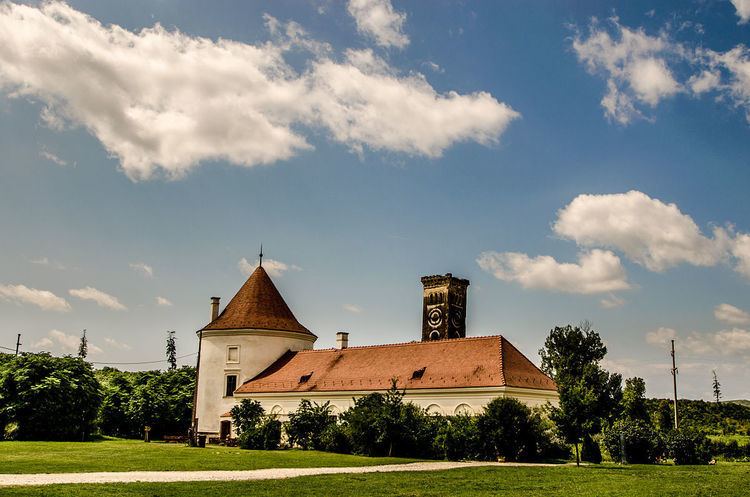Status Renovated Owner Katalin Bánffy | Type Castle Renovated 1999–present Architectural style Baroque | |
 | ||
Architect Joseph Emanuel Fischer von Erlach Similar Cluj‑Napoca Bánffy Palace, Bánffy Castle, Kornis Castle, Château Teleki, Gilău Castle | ||
2013 jun bon ida b nffy castle
Bánffy Castle is an architectural monument situated in Bonţida, a village in the vicinity of Cluj-Napoca, Romania, with construction phases and stylistic features belonging to Renaissance, Baroque, Neoclassical and Neogothic styles. It is owned by the Bánffy family (of which Miklós Bánffy was a member). The current owner is Katalin Bánffy.
Contents
History
In 1387, the Bonțida estate came into the possession of the Bánffy of Losonc family, when Sigismund of Luxemburg donated it to Dénes, son of Tamás Losonci. The present castle was preceded by a manor house, whose history dates back to the 15th-16th centuries. After 1640, the estate was inherited by Dénes Bánffy (II) (1638–1674), county governor of Dăbâca and Cluj counties, brother-in-law and counselor of Prince Michael I Apafi, who fortified the initial building between 1668 and 1674 by surrounding it with curtain walls that formed a rectangular enclosure, reinforced at the corners with massive circular towers. The castle could be accessed through a seven-storey high gatehouse located on the fortification's eastern side. The works were continued after his death by his successor, György Bánffy (III).
This Renaissance ensemble was involved, between 1704 and 1711, in Rákóczi's War of Independence, needing repairs and restorations at the beginning of the 18th century.
In the 18th century the estate was inherited by Dénes Bánffy (IV), who, after a time spent in the Viennese Court of Empress Maria Theresa, returned home in 1747 and started a reconstruction of the castle in Austrian Baroque style. Between 1747 and 1751 a Cour d'honneur in U shape was built to the eastern side of the Renaissance building, which contained: the riding school, the stable, the carriage rooms and servants' quarters. An important achievement was the castle's park near the Someș River, with walkways, statues and fountains. In the integrative concept specific to Baroque art, the residence and the environment were in a relationship of close interdependence and mutual influence. Based on this concept, the park of 70 ha was set up after the design of architect Johann Christian Erras, which transposed into this space forms dominated by a strict geometry. The sculptor Johann Nachtigall made grandiose stone statues inspired by the ancient poet Ovid.
József Bánffy, the descendant of Dénes Bánffy, decided the demolition of the gate tower in the 1820s, uniting the Renaissance courtyard with the Baroque one, and from the resulting stone a water mill was built for the villagers in Bonțida. In 1850 building's western wing was modified under the direction of architect Anton Kagerbauer (1814–1872), following the park's landscaping after the English Romanticism model.
In 1944, the castle was transformed into a field hospital. German troops plundered and devastated the castle, as retaliation against political attitude of its owner, count Miklós Bánffy, which has initiated negotiations between the governments of Romania and Hungary for the return of weapons against Germany. Thus, the furniture, the library and the gallery of paintings were destroyed.
During the communist regime, whole building was used as a driving school, cooperative farm and hospital for children. In 1963, Bánffy Castle was used as decor for filming Pădurea spânzuraților, directed by Liviu Ciulei. The film comprised a short scene with fire, thus scenographers lit one of the buildings, causing massive damage to the building.
In 1990, the castle was declared a historic monument.
Restoration
In 1999, due to its ruinous state, the castle was included, at the request of the Transylvania Trust, in the World Monuments Watch List of 100 Most Endangered Sites. Also in 1999, a bilateral State Agreement was signed between Romania and Hungary for the restoration and rehabilitation works. In the following period, with Romanian state funds, about 2/3 of the main building's roof was reconstructed. In 2003, the Transylvania Trust signed with the authorities a long-term lease agreement for the castle, resigned with Katalin Bánffy in 2008 (who was given back the building in the meantime) for the duration of 49 years. In 2001, the Built Heritage Conservation Training Program was implemented, the kitchen buildings being the first one to be restored under its banner. In 2005, The Built Heritage Conservation Training Centre was officially opened at Bánffy Castle, which functions to this day, teaching traditional building crafts skills for the restoration, repair and maintenance of historic buildings and which was awarded, in 2008, the Europa Nostra prize in Cultural Heritage for education, training and awareness training. The program is supported by His Royal Highness, Prince Charles of Wales, who visited the castle. The patron of the training centre is Her Royal Highness, Princess Margareta of Romania.
